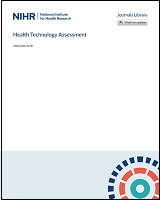NCBI Bookshelf. A service of the National Library of Medicine, National Institutes of Health.
Parr J, Pennington L, Taylor H, et al. Parent-delivered interventions used at home to improve eating, drinking and swallowing in children with neurodisability: the FEEDS mixed-methods study. Southampton (UK): NIHR Journals Library; 2021 Mar. (Health Technology Assessment, No. 25.22.)

Parent-delivered interventions used at home to improve eating, drinking and swallowing in children with neurodisability: the FEEDS mixed-methods study.
Show detailsMarshall et al.5 review update
| Study (first author and year of publication) | Study design | Intervention | Timescale of intervention | Outcomes | Outcome measures | N | Age range | ASD diagnosis |
|---|---|---|---|---|---|---|---|---|
| Johnson 201524 | Before and after | Manualised Parent Training – Feeding (group-based behavioural intervention) | 9 × 1–1.5 hours (over 16 weeks) | Mealtime behaviours, disruptive behaviours, dietary intake, parent stress and caregiver satisfaction | BAMBI, ABC, PSI-SF, 3-day food records, Caregiver satisfaction and effectiveness questionnaire (bespoke, non-validated) | 14 | 3 years 4 months to 6 years 2 months | Met diagnostic criteria according to DSM-IV and confirmed by ADOS in study |
| Marshall 201522 | RCT | Systematic desensitisation (SD) vs. operant conditioning (OC): both with parent training | 10 sessions (weekly or intensively) | Dietary intake and variety, mealtime behaviours, weight, height, BMI, behaviour outside mealtimes and parent stress | 3-day food records, food lists, BPFAS, ECBI and PSI-SF | 68 | 3 years 1 month to 5 years 2 months | Documented diagnosis by paediatrician, psychologist or psychiatrist: not formally assessed in study |
| Peterson 201623 | SCEDa | Applied behaviour analysis (ABA) vs. modified sequential oral sensory (MSOS) programme | 1.5 hours 3 times per week: ABA = 9–16 sessions; MSOS = 15–19 sessions | Food acceptance, mouth clean, inappropriate mealtime behaviours and grams consumed | N/A | 6 | 4–6 years | Diagnosis given by MDT using structured interview, ADOS and mental state exam: not formally assessed in study |
| Sharp 201421 | RCT | Group parent training – behavioural intervention vs. waiting list control | 8 × 1-hour sessions (over 6 weeks) | Mealtime behaviours, dietary variety, feasibility, parent stress and caregiver satisfaction | BAMBI, FPI, PSI-SF, caregiver satisfaction and effectiveness questionnaire | 19 | 3–8 years | DSM-IV and SRS used to confirm diagnosis in study |
ABC, Aberrant Behaviour Checklist; ADOS, Autism Diagnostic Observation Schedule; DSM-IV, Diagnostic and Statistical Manual of Mental Disorders 4th Edition; ECBI, Eyberg Child Behaviour Inventory; FPI, Food Preference Inventory; N/A, not applicable; PSI-SF, Parenting Stress Index Short Form; SCED, single-case experimental design; SRS, Social Responsiveness Scale.
Note
Descriptions: SD – bottom-up play-based modelling; OC – top down, prompt and reward; ABA – behavioural intervention; MSOS – systematic desensitisation.
National Institute for Health and Care Excellence guidelines review (2017)6 update
| Study (first author and year of publication | Study design | Intervention | Timescale of intervention | Outcomes | Outcome measures | N | Age range |
|---|---|---|---|---|---|---|---|
| Serel Arslan 201725 | RCT | FCTa vs. OMEb | FCTa = 12 weeks OMEb = 12 weeks | Chewing performance and feeding behaviours | KCPS and BPFAS | 80 | 1 year 1 month to 5 years 7 months |
| Song 201526 | RCT | OSTc + NMES vs. OSTc + NMES shamd | 8 weeks | Feeding behaviours and severity of dysphagia | BASOFF and NOMSe swallowing scale | 20 | 3 years 4 months to 8 years 9 months |
BASOFF, Behavioural Assessment Scale of Oral Functions of Feeding; FCT, functional chewing training; KCPS, Karaduman Chewing Performance Scale; NMES, neuromuscular electrical stimulation; NOMS, National Outcome Measurement System; OME, oral motor exercises; OST, Oral Sensorimotor Treatment.
- a
FCT refers to functional chewing training – posture sensory and motor training, food and environmental modification.
- b
OME refers to oral motor exercises (passive and active exercises of the lips and tongue).
- c
OST refers to oral sensorimotor treatment – oral stimulation (child passive).
- d
NMES sham refers to neuromuscular electrical stimulation equipment applied to child but not turned on.
- e
NOMS refers to the American Speech–Language–Hearing Association’s National Outcome Measurement System.
- Data extraction for systematic reviews - Parent-delivered interventions used at ...Data extraction for systematic reviews - Parent-delivered interventions used at home to improve eating, drinking and swallowing in children with neurodisability: the FEEDS mixed-methods study
Your browsing activity is empty.
Activity recording is turned off.
See more...